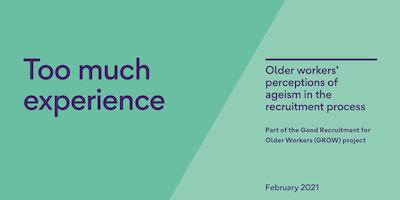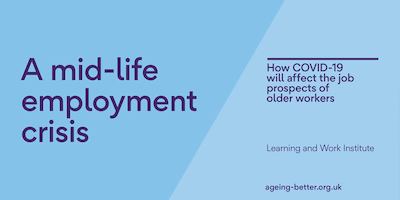Older workers with health conditions disproportionately sidelined from work because of ageism

Our new comprehensive health and work evidence review finds older people with a long-term health condition more likely to be out-of-work than younger peers.
The Centre for Ageing Better is calling for an end to the current age-neutral approaches to employment support that have largely not worked, and have instead stoked imbalance and unfairness.
Millions of older workers with health conditions face years of financial uncertainty before retirement because of a substantial drop in employment rates as they enter the final third of their working lives, the Centre for Ageing Better is warning in a new evidence review.
Widely-held ageist assumptions underestimating the value and capacity of older workers, difficulties accessing reasonable adjustments to stay in work and less effective employment support for older age groups means many are ending working lives long before they are ready to, the new review details.
The new health and work review by the Centre for Ageing Better reveals a substantial health-related employment gap that widens with age. Fewer than three in five (57%) people aged 50-65 who have a long-standing health condition are in employment, compared to almost three in four (73%) aged 35-49.
This means that people with a long-term health condition are 60% more likely to be out of work if they are over 50.
The review also finds that people with a long-term health condition after 50 are much less likely to be in work than younger age groups despite there being little to no difference by age in the proportions of people who consider their health condition “work-limiting”.
The UK has a 50% higher rate of economic inactivity due to illness among people both aged 50-64 and who want to work compared to Germany, and also fares poorly in comparison with France and Italy.
Closing this gap would see around 192,000 additional older workers in the labour market, yielding approximately £13 billion in gross domestic product (GDP) a year and £2.5 billion in additional income tax and national insurance revenues, details the new analysis from the Centre for Ageing Better.
The Centre for Ageing Better review calls for a more age-positive approach to the labour market, replacing the current age-neutral approaches that have largely not worked, and have instead stoked imbalance and unfairness.
Among its recommendations, the review calls for:
- Government to commit to an employment rate target of 75% for people aged 50-64 by 2030
- Clear and ambitious performance targets for cohorts of people aged 50-59, and 60-65, for all DWP-funded employment support and health and work interventions
- Restart and expand the Midlife MOT pilot programme
- Expand and improve the 50 PLUS Champions scheme within Jobcentre Plus
- Specialist interventions to support people in their fifties and sixties with health conditions to return to the workforce.
Dr Emily Andrews, Deputy Director for Work at the Centre for Ageing Better, said
“In the decades prior to the pandemic, the UK’s employment growth was largely driven by increasing the participation of workers aged 50 and over.
“This trend has now stalled and for Labour to meet its growth mission and ambitions of an 80% employment rate, their health and work initiatives will need to work for people in their fifties and sixties. This will complement the drive to increase youth participation in the labour market, and together create a strong multigenerational workforce.
“To achieve this, we need an age-positive tone from this government in its communications and actions. Setting high standards for its interventions to deliver for the over 50s age group will send a clear signal that older workers with long-term health conditions can and should be supported to access employment.
“It is clear that it is not 50+ workers’ health that is holding this age group back from fulfilling their full potential, it is the failure of employment support and a significant proportion of employers in not giving them the opportunities to contribute fully to organisations and the economy.”
The newly published review highlights the disproportionate numbers of older workers currently shut out from the labour market and the significant economic prizes on offer if the government can get even a small proportion back into work.
Over half (53%) of the 3 million people currently economically inactive due to long-term illness or disability, are between 50 and 65.
Similarly, four in ten (42%) of the 1.2 million people with a long-standing health condition, who are not in work but would like to be, are aged 50 and over.
Increasing the employment rate for people aged 50-64 to 75% by 2030 would add £9 billion a year to the economy, and generate an additional £1.6 billion in national insurance and income tax contributions.
To reach this target would only require about 125,000 workers aged 50-65 to re-enter the labour market – the equivalent of one in four people in this age group who are out of work with a long-standing health condition who would like to work.
The review also dispels the myth that long-term illness will inevitably force older workers out of the labour market, detailing how people over 50 make up more than 40% of the 10.75 million currently in-work with a long-standing health condition.
Dr Carole Easton OBE, Chief Executive of the Centre for Ageing Better, said:
“Older workers with long-term health conditions already make a sizeable and vital contribution to the UK economy. But this contribution could be so much more if we swept away the prejudices, stigma and ageism that limits the opportunities for many older workers.
“If the government develops the right support tailored to older workers’ needs and delivers the right age-positive messaging to employers, workers in their fifties and sixties can help drive the country towards greater economic growth and tackle our substantial labour and skills shortages.
“One thing is clear: with the state pension age set to rise again to 67 by the end of this parliament, we cannot continue to accept that poor labour market outcomes for people in their sixties with long-term health conditions are inevitable.”








